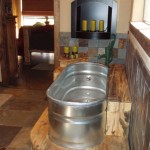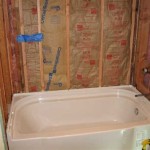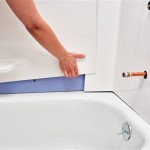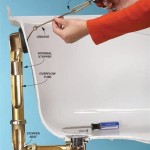How to Replace a Two-Handle Bathtub Faucet Cartridge: A Delta Guide
A bathtub faucet cartridge is a small but vital component responsible for controlling water flow and temperature. Over time, these cartridges can wear out, leading to leaks, drips, or difficulties in adjusting the water flow. If you are experiencing these issues with a Delta two-handle bathtub faucet, replacing the cartridge is often the most effective solution. This process can be relatively straightforward, although the specific steps may vary depending on your faucet model. Here's a comprehensive guide to help you through the replacement process.
Step 1: Gather Your Tools and Materials
Before you begin, ensure you have the necessary tools and materials. This will make the process smoother and help avoid delays. Here's what you'll need: *
Replacement cartridge:
It is crucial to purchase the correct replacement cartridge for your specific Delta faucet model. You can find the model number on the faucet itself or refer to the user manual. Consult with a hardware store or plumbing supply store for the right replacement cartridge. *Adjustable wrench:
This is essential for loosening and tightening nuts and other parts on the faucet. *Channel-lock pliers:
These pliers are helpful for gripping and turning stubborn parts. *Phillips screwdriver:
You may need a Phillips screwdriver to remove the handle screws. *Flathead screwdriver:
This may be necessary for removing decorative caps or other faucet components. *Plumber's tape:
This is used to create a watertight seal around the faucet threads. *Bucket or basin:
This is to catch any water that may leak out during the process. *Safety glasses:
Wear protective eyewear to prevent debris from entering your eyes. *Gloves:
Protect your hands from any sharp edges or water.Step 2: Turn Off the Water Supply
Before attempting any repairs, it is essential to shut off the water supply to your bathtub. This prevents water from flooding your bathroom during the replacement process. Locate the shut-off valves for your hot and cold water lines. These valves are usually located underneath the sink or in the basement. Turn the valves clockwise until they are completely closed. You can check if the water supply is off by turning on the faucet and confirming that no water flows out.
Step 3: Remove the Faucet Handles
Start by removing the faucet handles. Locate the set screws on the underside of each handle. These screws may be hidden under a decorative cap. Use a Phillips screwdriver or flathead screwdriver to remove these screws. Once the screws are removed, the handles should detach from the faucet. If the handles are stubborn, use a channel-lock pliers to gently pry them off. However, be cautious to avoid scratching or damaging the faucet finish.
Step 4: Remove the Stem and Cartridge
With the handles removed, you will need to access the cartridge. Locate the stem, which is the cylindrical part that connects the handle to the faucet body. The stem may have a nut or a retaining clip holding it in place. Use an adjustable wrench to loosen the nut or remove the retaining clip. Once the stem is free, carefully pull it out of the faucet body. The cartridge is attached to the stem, so it will come out with it. Inspect the old cartridge for signs of wear and tear, such as cracks, debris, or corrosion. This will help you confirm that you need a new cartridge.
Step 5: Install the New Cartridge
Take the new cartridge and align it with the stem. Since the cartridge is a critical component of the faucet, ensure there is a proper fit. Gently push the cartridge onto the stem until it is fully seated. Next, reinstall the stem into the faucet body. Make sure the stem is pushed in all the way and that the nut or retaining clip is secured. If the stem is difficult to push in, remove the cartridge and re-align it with the stem. Make sure the seal on the cartridge is in the correct position.
Step 6: Reassemble the Faucet
After installing the new cartridge, reattach the handles to the faucet. Align the handles with the stem and screw them back into place using the set screws. Once the handles are secured, turn on the water supply to test the faucet. Check for any leaks or drips at the connections. If you notice any leaks, tighten the connections further using the adjustable wrench. If you are comfortable with the faucet, allow the water to run for a few minutes to flush out any debris that may have accumulated during the replacement process.
Replacing a bathtub faucet cartridge can be a simple DIY project that can significantly improve your bathroom's functionality. By following these steps and using the right tools and materials, you can efficiently replace the cartridge and ensure a smooth and leak-free water flow. If you encounter any difficulties or are unsure about the process, it is always advisable to consult with a qualified plumber for assistance.

Delta Shower Faucet Cartridge Replacement 1700 Monitor Leak Repair

How To Fix A Leaking Dripping Delta Bathtub Faucet 2

How To Replace A Delta Tub Or Shower Cartridge

How To Replace A Delta Cartridge And Fix Leaky Bathtub Faucet It Tutorials

How To Stop Delta Faucet From Dripping Two Handle Repair Kit

Fast Way To Replace Or Retrofit A Two Handle Shower System With One

Delta Monitor Shower Valve Cartridge Replacement

Fast Way To Replace Or Retrofit A Two Handle Shower System With One

2 Handle Shower Faucet Replacement 1 Tom Plumber

Two Handle Cartridges Delta Faucet
Related Posts








